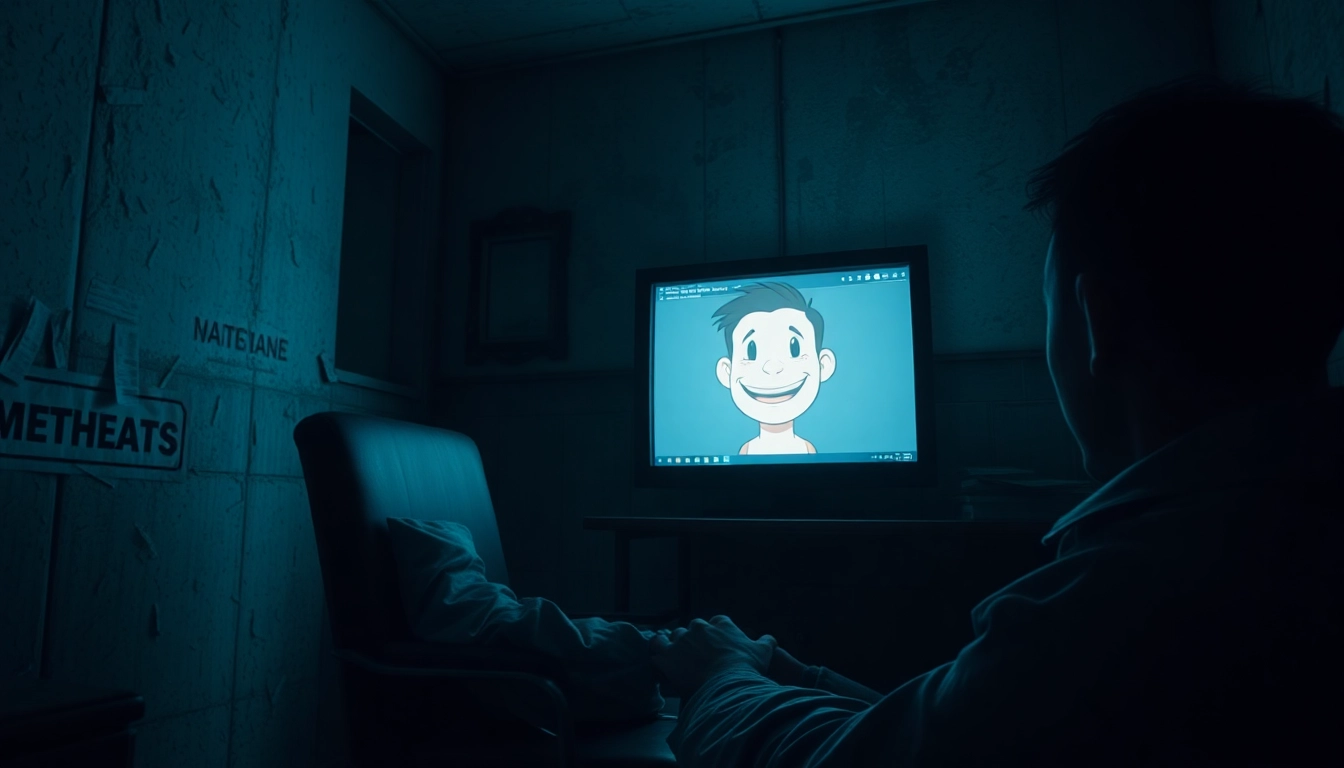Overview and Context: BloodMoney — A Psychological Horror Clicker Experience
In the realm of indie horror games, few titles manage to combine psychological depth with interactive gameplay as compellingly as blood money. This dark and disturbing clicker game plunges players into a morally ambiguous scenario where every action is fraught with consequences. Crafted to challenge notions of morality, empathy, and human nature, BloodMoney invites players to navigate a treacherous landscape of ethical dilemmas, psychological horror, and relentless pressure. Its unique mechanics, narrative depth, and visceral visuals make it a standout in the genre, prompting players to ask: How far are you willing to go when your life—and your conscience—are on the line?
The Dark Narrative of BloodMoney: A Tale of Desperation and Morality
BloodMoney tells a haunting story centered around a protagonist faced with an urgent medical crisis. You have been diagnosed with a severe health condition requiring immediate treatment, but the staggering cost of $25,000 stands as an insurmountable barrier. With time running out, the game introduces a sinister opportunity—interacting with Harvey, a cheerful and seemingly innocent character, who offers a disturbing solution: click on him to generate money. The narrative swiftly morphs from a simple monetary quest into a disturbing exploration of morality, suffering, and human resilience.
Game Mechanics and Core Gameplay Elements
Clicking Mechanics: The Heart of BloodMoney
The primary gameplay revolves around clicking on Harvey, a bright and cheerful figure who, with each tap, provides a direct monetary reward. Initially, each click seems harmless—harmless even charming—creating a sense of simplicity and immediacy. However, this mechanic is deliberately designed to evoke moral tension; as the player clicks more, Harvey’s suffering intensifies, visually and psychologically, with his reactions becoming increasingly distressed. This subtle visual storytelling underscores the game’s core theme: every profit gained comes at a human cost.
Upgrade System and Increasingly Disturbing Tools
To accelerate the earning process, players can purchase upgrades from the in-game shop. These upgrades escalate in brutality—from needles causing pain to hammers inflicting more severe trauma. Each purchase boosts earnings but also deepens Harvey’s suffering, creating a twisted risk-reward dynamic. The game cleverly employs visual cues—Harvey’s grimaced face, trembling limbs, and distressed dialogue—to reinforce the emotional toll of each upgrade. The more violent the tool, the darker the moral landscape becomes, forcing players to confront their own boundaries.
Multiple Pathways and Endings
BloodMoney offers three distinct endings, each shaped by the player’s choices and upgrade decisions:
- The Good Ending: Minimizing Harvey’s suffering, opting for less violent tools, and approaching the goal with empathy and restraint.
- The Normal Ending: Balancing profit and suffering, employing moderate tools like scissors or needles, leading to a morally ambiguous resolution.
- The Bad Ending: Maximizing efficiency at any human cost, using the most violent tools such as hammers or knives, culminating in a grim conclusion that highlights greed and moral decay.
These endings are not merely plot points but serve as reflections of the player’s moral compass, making each playthrough a deeply personal experience.
The Psychological Horror and Visual Storytelling
BloodMoney masterfully combines minimalist visuals with intense emotional storytelling. As the player progresses, Harvey’s appearance subtly changes—his eyes grow more hollow, his posture more slumped, and his expressions more pained. These visual cues, coupled with dialogue that shifts from cheerful to terrified, evoke a visceral sense of unease. The game’s art style, often stark and unsettling, amplifies the psychological horror, making players feel complicit in Harvey’s torment.
Moreover, the game employs a clever use of sound design and visual effects—distorted voices, trembling animations, and increasingly grotesque imagery—to evoke anxiety and moral conflict. These elements work together to create an atmosphere that is both compelling and discomforting, forcing players to question their own motives and the nature of human depravity.
Time Pressure and Urgency
Adding to its tension, BloodMoney incorporates a pressing countdown—players must raise the required $25,000 before time runs out. This element ramps up the psychological pressure, simulating real-life stress and urgency. Every second counts, and the choices made under this stress become even more morally charged. Do you prioritize speed over ethics? Or do you slow down to consider each click’s impact? The game’s design ensures that players confront these dilemmas at every turn, heightening emotional stakes.
Multiple Endings and Moral Consequences
The Path of Morality: The Good Ending
Choosing to minimize Harvey’s suffering involves cautious upgrades, avoiding the most violent tools, and showing restraint. Achieving this ending signifies that the player values human life and moral integrity over profit. The narrative concludes with Harvey surviving, albeit scarred, and the protagonist reflecting on their choices. This ending prompts introspection about the importance of compassion even in dire circumstances.
The Balanced Approach: The Normal Ending
This route involves a mix of upgrades, employing some violence but not pushing beyond moral boundaries. Harvey’s suffering increases, but not to catastrophic levels. The ending reveals a compromise—survival is achieved, but at a moral cost. The game suggests that balance is possible, yet it leaves lingering questions about the true cost of such compromises.
The Path of Maximal Profit: The Bad Ending
Maximizing profits regardless of Harvey’s pain, using the most brutal tools, results in the worst ending. Harvey’s suffering is extreme, his appearance grotesque, and the protagonist’s morality is shattered. This ending starkly illustrates the destructive nature of greed and moral indifference, leaving players to grapple with the darker aspects of human nature.
Community Insights and Player Interpretations
The BloodMoney community is vibrant, with players sharing theories and moral reflections. Many have noted Harvey’s reactions—particularly his surprise at the violent tools—suggesting he might be unaware of what’s in the shop. This detail raises profound questions: Does Harvey represent innocence? Is he a pawn controlled by darker forces? Such observations deepen the game’s narrative complexity, prompting discussions about morality, innocence, and the nature of evil.
Players also report that, with skillful play, it’s possible to reach the Good Ending even when using certain violent tools like the hammer, indicating subtle depth in the game’s tracking of moral choices. This nuance encourages multiple playthroughs and introspection, making BloodMoney a thought-provoking experience for gamers and critics alike.
The Moral and Philosophical Reflection
BloodMoney acts as a mirror to human nature, illustrating how desperation can erode morality. It questions whether survival justifies immoral acts and examines the duality of human empathy versus greed. The game’s design forces players to confront uncomfortable truths: Are we inherently good, or do circumstances reveal our darker sides?
Through its unsettling mechanics and narrative, BloodMoney suggests that morality is a spectrum—one that can shift based on context, necessity, and personal choice. Its commentary on human behavior makes it more than just a game; it’s a provocative exploration of the psychological and ethical boundaries that define us.
Comparing BloodMoney to Other Horror and Clicker Games
While many horror games focus on jump scares or overt gore, BloodMoney excels in psychological horror—creating dread through subtle cues, moral ambiguity, and emotional storytelling. Its clicker mechanics, reminiscent of idle games, are repurposed to serve a darker purpose, emphasizing the toll of greed and moral compromise.
Compared to traditional clicker games, such as Cookie Clicker or Clicker Heroes, BloodMoney integrates narrative depth and moral choices, elevating it into a genre-blending experience. Its focus on psychological torment distinguishes it from other horror titles, which often rely on external shocks rather than internal moral conflict.
Furthermore, its influence can be seen in other indie titles that explore morality and human depravity, positioning BloodMoney as a significant entry in the evolution of psychological horror gaming.
Final Reflections: How Far Would You Go for Survival?
BloodMoney challenges players’ perceptions of morality, forcing them to weigh their own values against the instinct to survive. It’s an intense, visceral experience that questions the very fabric of human decency under extreme pressure. Would you opt for the path of compassion, or would greed push you toward brutality? Each choice leads to a different reflection on human nature, making the game a compelling moral experiment as much as a horror experience.
As you ponder your own limits, remember that this game is more than a mere entertainment—it’s a mirror, a test, and an invitation to examine what you truly value. How far are you willing to go when your own life is at stake? The answer depends on your choices, your morality, and your courage.
For those intrigued by the dark depths of human psychology and morality, exploring blood money promises an unsettling journey that lingers long after the screen goes dark. Are you prepared to face your own moral boundaries?
















